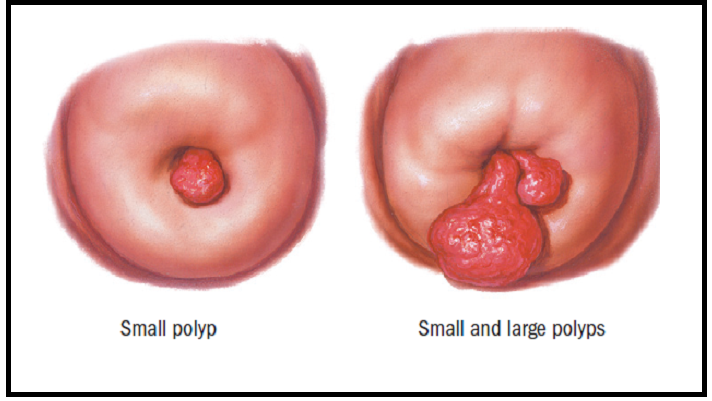Cervical polyps are small, elongated tumours that grow on the cervix. The cervix is the narrow canal at the bottom of the uterus that extends into the vagina. Polyps are fragile structures that grow from stalks rooted on the surface of the cervix or inside the cervical canal. There is usually only one polyp present—or at most, two or three.
Cervical polyps occur in about four percent of women of reproductive age. They are most common in women in their 40s and 50s who have had more than one child. Polyps almost never occur in young women prior to the start of menstruation. Polyps are also common during pregnancy. This may be caused by an increase in the hormone oestrogen.
Cervical polyps are usually benign (not cancerous), and the chances of them leading to cervical cancer are rare.
Symptoms of Cervical Polyps
Polyps on the cervix may not cause any noticeable symptoms. However, if any of the following symptoms occur, see your gynaecologist right away:
- vaginal discharge of white or yellow mucus (leucorrhea)
- vaginal spotting or bleeding: after sexual intercourse (post coital), between periods (inter-menstrual), after douching, after menopause (postmenopausal)
- abnormally heavy periods (menorrhagia)
Some of these symptoms can also be signs of cancer. In rare cases, polyps could represent an early phase of cervical cancer. Removing them helps reduce this risk.
Ask your doctor how often you should get regular pelvic examinations and pap tests. Recommendations can vary with a patient’s age and health history.
Why Polyps Occur

It is not fully understood why cervical polyps occur. Their formation may be linked to:
- increased levels of oestrogen (female sex hormone)
- chronic inflammation in the cervix, vagina, or uterus
- clogged blood vessels
High Oestrogen Levels
Oestrogen levels naturally fluctuate throughout a woman’s life. The most common times are during menstrual cycles, pregnancies, and in the months leading up to menopause. For example, oestrogen levels can reach 100 times the normal range during pregnancy.
Man-made chemicals that mimic oestrogen are present everywhere in our environment today. For example, xenoestrogens are found in commercially produced meats and dairy products.
Chemical oestrogens can also be released into food that is heated in Styrofoam or plastic containers. Even some air fresheners contain phthalates, another oestrogen-like chemical.
Inflammation
An inflamed cervix appears red, irritated, or eroded. Some of the known causes of cervical inflammation include:
- bacterial infection
- condyloma cuminata virus (warts)
- human papillomavirus (HPV) infection
- herpes
- yeast infections
- pregnancy, miscarriage, or abortion
- hormonal changes
HPV infection is also a known cause of cervical cancer. Regular pelvic exams and pap tests (also called pap smears) are an important precaution for women of any age. The pap test is done by scraping a small amount of tissue from the cervix, which is sent to a laboratory. The test checks for infection and abnormal cells.
How Cervical Polyps Are Diagnosed
Polyps are easy to see in a routine pelvic examination. The doctor will see smooth, finger-like growths on the cervix that appear red or purple in colour. Polyps usually protrude out from the cervical canal.
Biopsies (tissue samples) of the polyps are taken and sent to a laboratory for testing. Results usually show benign polyp cells. In rare cases, there may be abnormal cells or neoplastic changes (precancerous patterns of growth).
Treatment of Cervical Polyps
There are different approaches to removing cervical polyps but you best option is going natural. Removing cervical polyps naturally will enable you to be sure of no negative side effect after the treatment.
If you are suffering from cervical polyps and you desire a natural way to get rid of it, then click here to read about the Cervical Polyps Remedy Kit.
The Kit has helped a lot of women get rid of cervical polyps naturally with no side effect and it can help you too.
If you have gained anything from reading this, don’t hesitate to share it with others too. Put your comments and questions or topics you will like us to write about in the comment box below.
Stay Healthy And Never Give Up!
Plan B Wellness
Email – consult@www.planbwellness.com
Twitter – @planbwellness
Instagram – @planbwellness









Thank you for the information
Pls am in ghana,what is price for the endometrial polyp in Ghana cedis